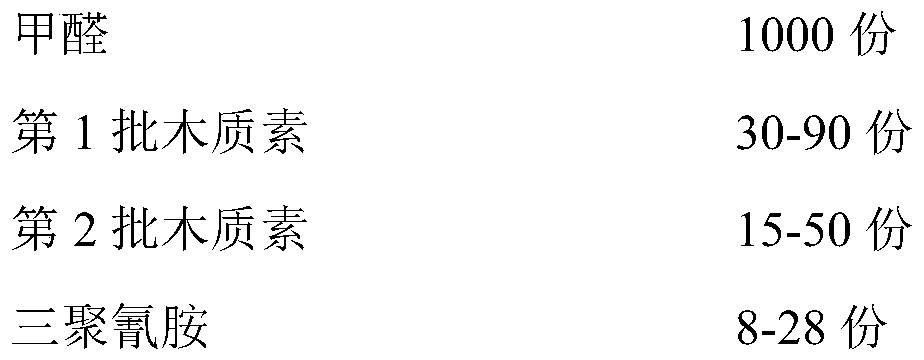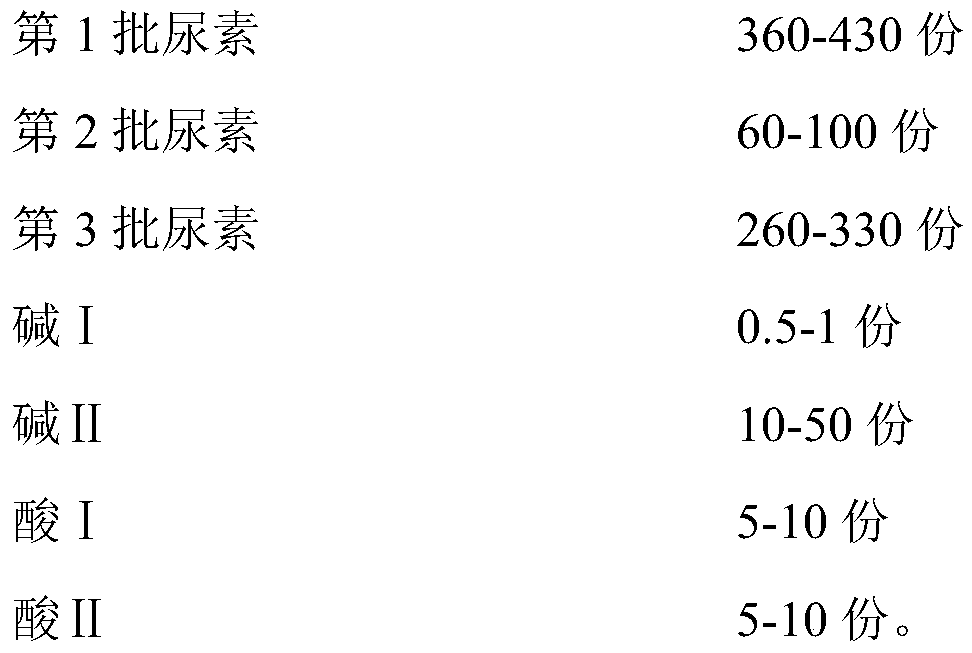Lignin modified urea-formaldehyde resin adhesive and preparation method and application thereof
A technology of urea-formaldehyde resin and lignin, which is applied in the direction of adhesives, aldehyde/ketone condensation polymer adhesives, adhesive types, etc., can solve the problems of high raw material cost, complicated process, poor water resistance, etc., and achieve quality control The method is simple, the preparation process is simple, and the effect suitable for popularization and application
- Summary
- Abstract
- Description
- Claims
- Application Information
AI Technical Summary
Problems solved by technology
Method used
Image
Examples
Embodiment 1
[0037]A preparation method of a lignin-modified urea-formaldehyde resin adhesive is as follows: add lignin in two batches, add urea in three batches, first add formaldehyde, the first batch of lignin and melamine for addition reaction; then add the first The first batch of urea and the second batch of lignin are subjected to the first polycondensation reaction; the second batch of urea is then added for the second polycondensation reaction; finally the third batch of urea is added for the third polycondensation reaction to obtain a lignin-modified urea-formaldehyde resin adhesive. Specifically include the following steps:
[0038] (1) Add 1000kg of formaldehyde into the reaction kettle, adjust the pH value to 7.3 with 0.7kg of sodium hydroxide solution, then add 35kg of the first batch of lignin and 17kg of melamine, raise the temperature to 70°C, keep it warm for 10min, and then adjust the pH with 7kg of formic acid The value is 6.5, and it is kept at 70°C for 27 minutes;
...
Embodiment 2
[0043] A preparation method of a lignin-modified urea-formaldehyde resin adhesive is as follows: add lignin in two batches, add urea in three batches, first add formaldehyde, the first batch of lignin and melamine for addition reaction; then add the first The first batch of urea and the second batch of lignin are subjected to the first polycondensation reaction; the second batch of urea is then added for the second polycondensation reaction; finally the third batch of urea is added for the third polycondensation reaction to obtain a lignin-modified urea-formaldehyde resin adhesive. Specifically include the following steps:
[0044] (1) Add 1000kg of formaldehyde into the reaction kettle, adjust the pH value to 7.2 with 0.8kg of ammonia water, then add 90kg of the first batch of lignin and 20kg of melamine, heat up to 50°C, keep it warm for 20min, and then adjust the pH value with 8kg of sulfuric acid solution 6.3, keep warm at 69°C for 28 minutes;
[0045] (2) Add 360kg of th...
Embodiment 3
[0049] A preparation method of a lignin-modified urea-formaldehyde resin adhesive is as follows: add lignin in two batches, add urea in three batches, first add formaldehyde, the first batch of lignin and melamine for addition reaction; then add the first The first batch of urea and the second batch of lignin are subjected to the first polycondensation reaction; the second batch of urea is then added for the second polycondensation reaction; finally the third batch of urea is added for the third polycondensation reaction to obtain a lignin-modified urea-formaldehyde resin adhesive. Specifically include the following steps:
[0050] (1) Add 1000kg formaldehyde into the reaction kettle, adjust the pH value to 7.3 with 0.8kg triethanolamine, then add 55kg of the first batch of lignin and 10kg melamine, heat up to 60°C, keep it warm for 15min, and then adjust the pH value with 7kg formic acid 6.7, keep warm at 68°C for 30 minutes;
[0051] (2) Add 430kg of the first batch of urea...
PUM
 Login to View More
Login to View More Abstract
Description
Claims
Application Information
 Login to View More
Login to View More - R&D
- Intellectual Property
- Life Sciences
- Materials
- Tech Scout
- Unparalleled Data Quality
- Higher Quality Content
- 60% Fewer Hallucinations
Browse by: Latest US Patents, China's latest patents, Technical Efficacy Thesaurus, Application Domain, Technology Topic, Popular Technical Reports.
© 2025 PatSnap. All rights reserved.Legal|Privacy policy|Modern Slavery Act Transparency Statement|Sitemap|About US| Contact US: help@patsnap.com



